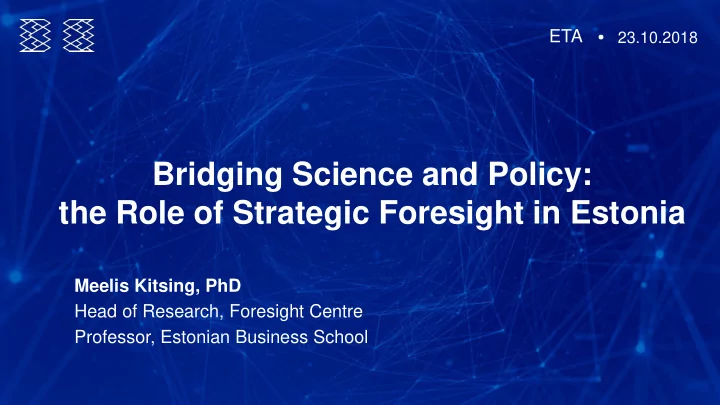

ETA 23.10.2018 Bridging Science and Policy: the Role of Strategic Foresight in Estonia Meelis Kitsing, PhD Head of Research, Foresight Centre Professor, Estonian Business School
The role of strategic foresight • Strategic foresight has gained considerable currency in policy and academic circles during the last decades. • Foresight in policy-making implies involvement of considerable number stakeholders with heterogeneous understanding of its role. • The heterogeneity goes beyond traditional debates among different schools of thought concerning design and implementation. • This presentation explores the role of strategic foresight on the basis of Foresight Centre in Estonia.
Supply and demand for foresight • Experience on the basis of domestic policy-making with members of parliament and other policy-makers as key stakeholders. • An attempt to develop policy scenarios in collaboration with various European think-tanks.
Twin deficits • A mismatch between supply and demand. – A significant gap in understanding of the nature of foresight emerges between heavy users and general policy-making community. • Some findings on the basis of our main method - scenario planning, – Scenario planning is often confused with forecasting and prediction. – Scenarios are sometimes seen as mutually non-exclusive policy options which all can be implemented. – Policy-makers tend to see scenarios as positive and negative depending on their preferences and ideological leanings. – Confusion about key drivers in scenario planning and whether key drivers can be shaped by policy-makers or not. – Policy-makers often assume that scenarios already include suggestions and recommendations for implementation of their favorable scenarios .
Derived demand • The "demand" for foresight is a derived demand, i.e. it depends ultimately on the demand for knowledge and policy insights that foresight helps to generate; • There is little or no demand for foresight for its own sake. • Many alternatives are available, particularly in a „post -truth “ era.
Supply-side implications • Improved communication for overcoming deficits in understanding. • Involvement of policy-makers in various steps of foresight processes. – Such as project steering committees where various steps of research process are elaborated. • Focus on education for tackling limited understanding and unrealistic expectations. – Educational events for policy-makers where nuts and bolts of various foresight methods are explored. – Alternative methods and their pros and cons should be discussed in social science classes at universities.
Thank you! meelis.kitsing@riigikogu.ee riigikogu.ee/arenguseire Arenguseire Keskus
Recommend
More recommend